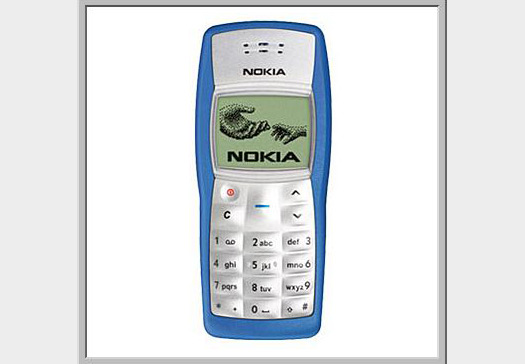
October 4, 2010
The Meek Shall Inherit the Market

Nokia’s 1100 cell phone does nothing but make calls. Price: $16.
Frugal engineering is a hot topic in development circles. A recent article in Strategy and Business magazine summarizes the virtues of “a cell phone that makes phone calls — and does little else; a portable refrigerator the size of a small cooler; a car that sells for about US$2,200 (100,000 rupees).”
Such objects are the fruits of “a powerful and ultimately essential approach to developing products and services in emerging markets,” the story explains. But frugal engineering is needed everywhere, and in fact, it has long been with us.
The iPod Nano is an example of frugal engineering as much as the Tata Nano — the $2,200 Indian “people’s car,” whose single windshield wiper sums up the impulse for austerity in product design. Versions of the tiny music player did away with the screen and controls of other iPods in an effort to lower the price as well as increase portability.
In its analysis of the most recent iPod Nano — the sixth generation — the market research firm Suppli found the manufacturing cost very low, just $45.10. Only “the fourth generation product had a less expensive BOM at the time of its introduction, at $40.80,” the group reported. The previous generation had included a scroll wheel controller and camera. These were eliminated. “Instead of piling on features, as so many brands do with their latest products, Apple with the sixth-generation iPod has maintained or even removed some attributes in order to fit the form factor and function desired,” wrote Andrew Rassweiler, an analyst with the firm. By making the product accessible to a less affluent part of its market, Apple not only attracts new customers, but may keep them for future purchases.
Many ideas of frugal engineering grow out of theories of technology appropriate to emerging or underserved economies, as derived from the books of Victor Papanek (Design for the Real World) and E.F. Schumacher (Small Is Beautiful). The results include the evaporative water filter called Watercone; crank-driven radios and other electrical devices for areas off the grid; and the recently much publicized “car parts” infant incubator, called Neonurture. The Spartan nature of these devices is appropriate to a limited infrastructure of energy and technical support.
But frugal engineering has another long tradition in its introduction of new technology. The Nano’s ancestor, the Model T, is exemplary. So are such classic American inventions as the balloon frame house and the Town truss bridge. In the world of consumer electronics alone, the Sony Walkman famously became a success when engineers took a full-function tape recorder used by reporters and secretaries and removed the recording equipment. The resulting machine was play-only. It was also less expensive and its lack of recording ability reassured record companies concerned about piracy.
More recent examples include the Flip digital video camera and the netbook configuration of laptop computer, which is used mostly to link to networks. These products reflect the state of fast-advancing technology but features like disc drives are left out.
A Wired magazine story last year highlighted “The Good Enough Revolution: ”When Cheap and Simple Is Just Fine.” But there is no revolution, only a basic principle. “Good enough” products have long been common in the development of new technologies. As the cost of the technology falls, as it typically does through economies of scale and other factors, more sophisticated, specialized models appear. The Model T remains the prime example, but also think of early personal computers like the Radio Shack TRS 80 (so crude it was nicknamed “Trash 80”) or the Kaypros and Osbornes that helped bring desktop computing to a wide audience three decades ago.
The world of military design and acquisitions is famous for cost and feature overruns. That may be why the great exception is so glaring: the famed Lockheed Skunk Works that developed the U-2 spy plane and F-117 stealth fighter. Because this group worked for intelligence agencies, hiding budgets in the nooks and crannies of normal appropriations, free from political influence, economy was a value. (The Skunk Works is often credited with coining the acronymic motto “KISS,” or “keep it simple stupid.”) It demonstrated that off-the-shelf parts make for frugal design. The U2 of the 1950s was cobbled together from many other airplane components. The F-117 of the 1970s was built with engines purloined from the F-18 fighter factory and a navigation system from the B-52 bomber.
Another exceptional story of military design is the Jeep’s. Although its origins in 1940 are made murky by many stories and claimed by many authors, the design clearly had to be vigorously scrubbed so it could meet military weight limits. This sort of editing is another from of frugality. An engineer named Delmar G. “Barney” Roos directed the process that stripped out every ounce of expendable structure, drilled holes in parts to lighten them and even deleted paint.
A recent interview with members of an Ikea design team showed a similar process at work, but in their case the cuts were in packaging and shipping. Ikea famously declares that “first we design the price tag.” It’s another way of saying frugality dominates. The designers reported that they changed the shape of a lamp so that more lamps would fit into each box and more boxes into each shipping container.
The impulse to economize can have beneficial aesthetic consequences. Consider the famous story of New York’s George Washington Bridge. Its carefully planned masonry exterior, designed by Cass Gilbert, architect of the Woolworth Building, was ultimately abandoned, after the bare steel skeleton proved so popular with the public that it was painted and left naked, the legend goes. (The real story may have been more complicated. Saving money, especially in the 1930s, had to have been a powerful incentive for the builders.)
Warehouse retailers like Costco have frugally designed the sales process by combining sales and transaction areas.
Frugal design in the developed world could be seen as an antidote to “feature creep,” the complexity and distractions of design associated with aggressive marketing in mature markets. As technologies fall in cost, feature creep adds bells and whistles to basic models. It is what keeps us from being able to buy a basic one-button toaster oven or other simple product. Frugal engineering demands — and is identical with — frugal design. Which capabilities are essential and which expendable are questions development teams must collectively answer. The challenge for mature technologies and saturated markets is to produce goods that are streamlined rather than bloated with unneeded features because little profit is left in basic technology.
Observed
View all
Observed
By Phil Patton
Related Posts

Arts + Culture
Nila Rezaei|Essays
“Dear mother, I made us a seat”: a Mother’s Day tribute to the women of Iran

The Observatory
Ellen McGirt|Books
Parable of the Redesigner

Arts + Culture
Jessica Helfand|Essays
Véronique Vienne : A Remembrance

Design As
Lee Moreau|Audio
Announcing: Design As Season Two
Recent Posts
“Dear mother, I made us a seat”: a Mother’s Day tribute to the women of Iran A quieter place: Sound designer Eddie Gandelman on composing a future that allows us to hear ourselves think It’s Not Easy Bein’ Green: ‘Wicked’ spells for struggle and solidarity Making Space: Jon M. Chu on Designing Your Own PathRelated Posts

Arts + Culture
Nila Rezaei|Essays
“Dear mother, I made us a seat”: a Mother’s Day tribute to the women of Iran

The Observatory
Ellen McGirt|Books
Parable of the Redesigner

Arts + Culture
Jessica Helfand|Essays
Véronique Vienne : A Remembrance

Design As
Lee Moreau|Audio

 Phil Patton is an author and curator who writes on autos for
Phil Patton is an author and curator who writes on autos for